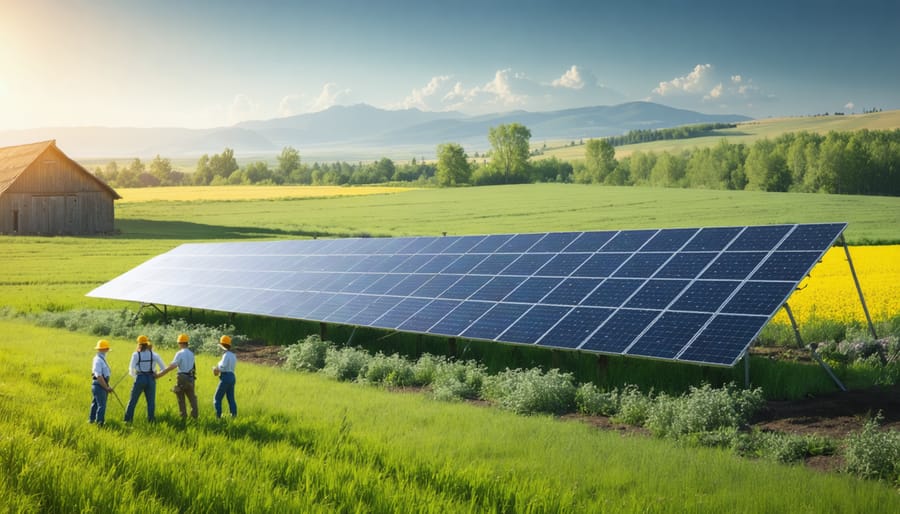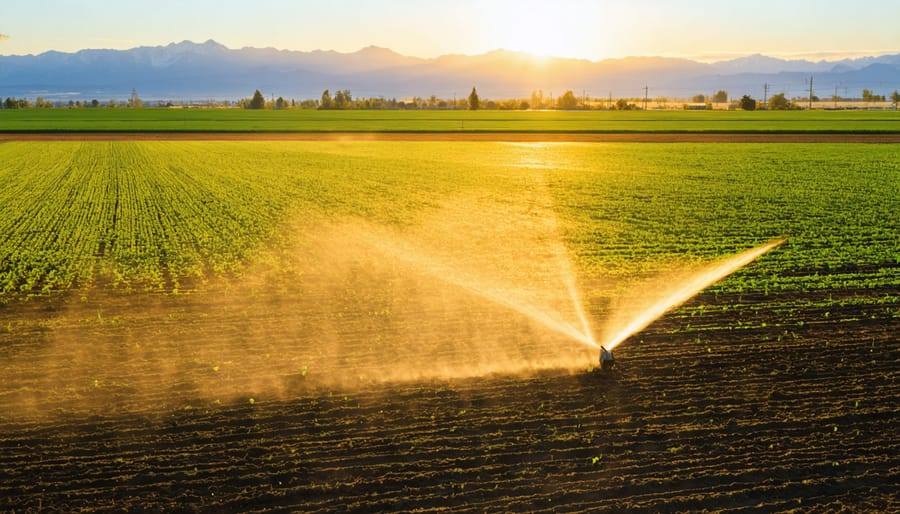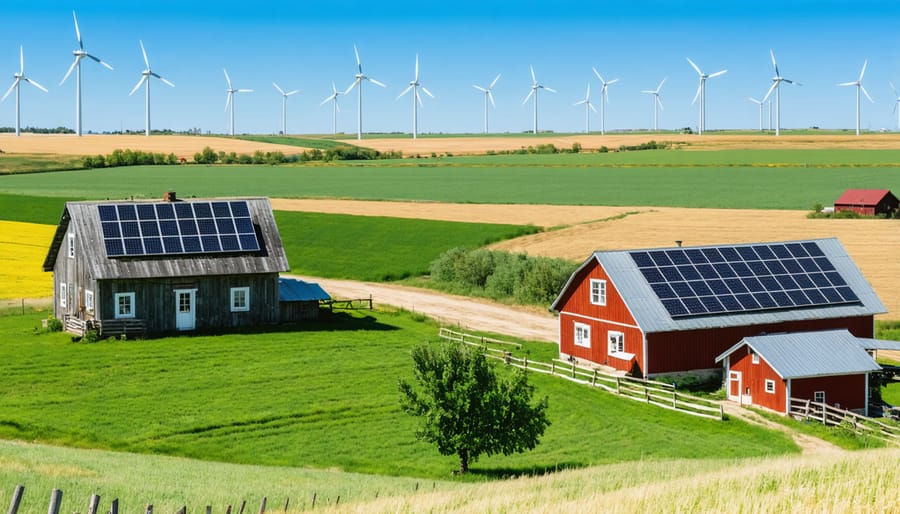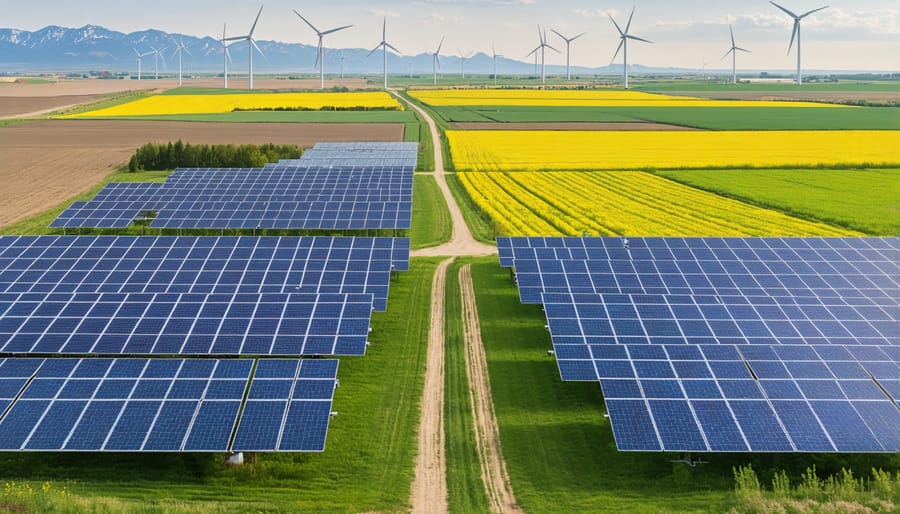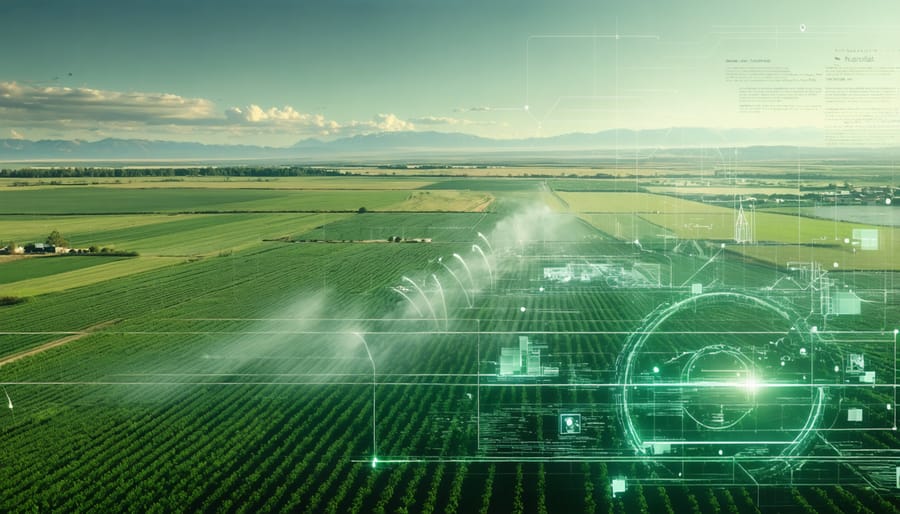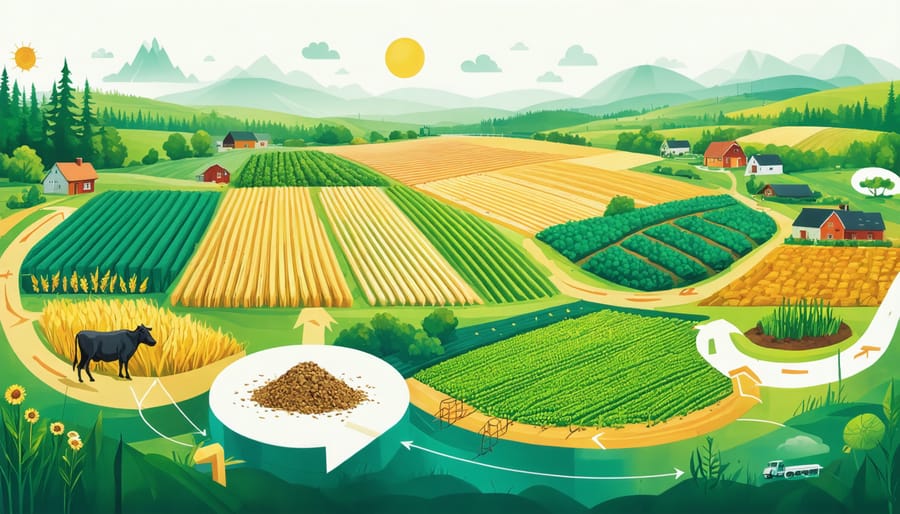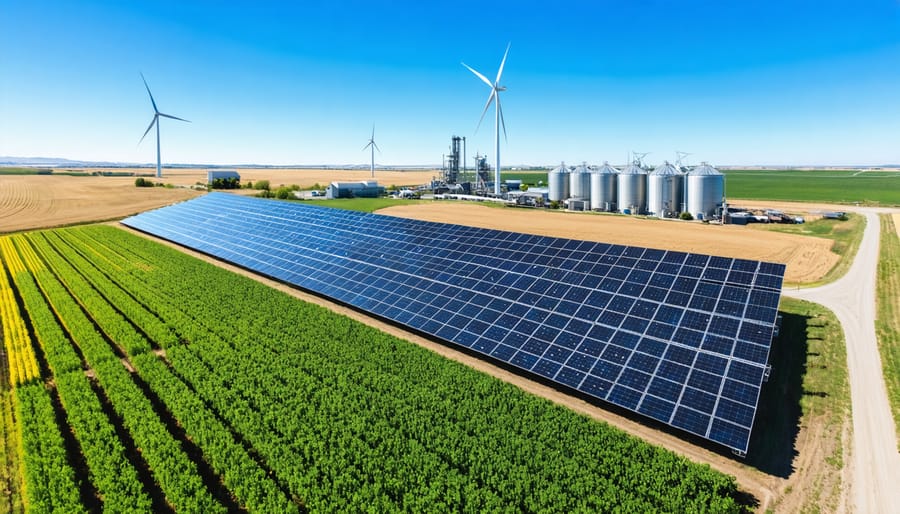Community solar projects in Alberta are delivering 15-30% energy cost savings for participating farmers while requiring zero upfront installation costs. As Alberta farmers tackle climate change, these shared solar initiatives offer a practical path to sustainable agriculture without the maintenance burden of individual systems.
Recent data from successful projects in Southern Alberta demonstrates that community solar subscribers save an average of $2,800 annually on electricity costs while contributing to grid stability during peak farming seasons. For agricultural operations consuming over 250,000 kWh annually, these programs provide guaranteed rates below market prices for 20-25 years, effectively hedging against rising energy costs.
Beyond the immediate financial benefits, community solar participants gain carbon credits tradeable in Alberta’s offset market, creating an additional revenue stream while supporting the province’s renewable energy targets. With flexible subscription models designed specifically for seasonal agricultural demands, farmers can match their energy procurement to production cycles without compromising operational efficiency.
How Community Solar Works in Alberta
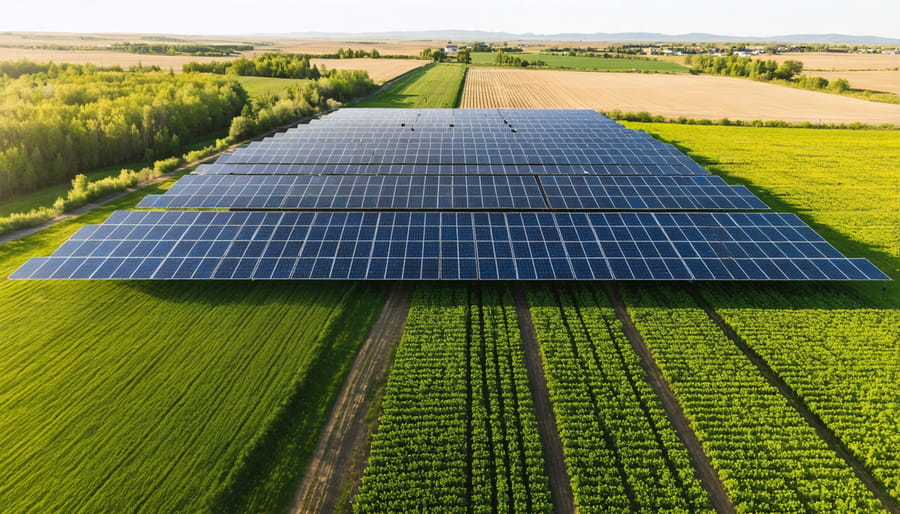
Local Program Structure
Alberta’s community solar program operates through a well-structured framework that makes participation accessible to farmers and rural residents. The Alberta Utilities Commission oversees these initiatives, ensuring fair practices and consumer protection. Participants can join existing projects or help establish new ones in their communities, with minimum investments typically starting at $2,000.
Most community solar projects in Alberta follow a cooperative model, where members purchase shares and receive credits on their electricity bills proportional to their investment. The programs usually require participants to be Alberta residents and customers of participating utility companies. Some initiatives specifically cater to agricultural operations, offering special terms for farms and ranches.
Local municipalities often partner with solar developers to create these programs, providing land and administrative support. Current projects range from 2 to 5 megawatts in size, serving anywhere from 200 to 500 households. Many programs offer flexible payment options and clear exit strategies, typically allowing members to transfer or sell their shares if needed.
The application process is straightforward, usually requiring proof of residency, utility account information, and initial investment capital. Most programs have a simple online registration system, with local support staff available to guide new participants through the process.
Subscription Models and Costs
Community solar projects in Alberta typically offer two main subscription models: pay-as-you-go and upfront purchase options. With pay-as-you-go, farmers can subscribe monthly based on their energy needs, usually paying $50-150 per month depending on farm size and energy consumption. This flexible approach requires minimal initial investment and allows for easy adjustment of subscription levels.
The upfront purchase model involves buying solar panels or a share of the project outright, typically ranging from $5,000 to $25,000. While this requires more initial capital, it often provides better long-term returns and fixed energy costs. Many projects offer financing options through local credit unions, with terms ranging from 5-15 years.
Both models include maintenance costs within the subscription fee, eliminating unexpected repair expenses. Some communities have implemented hybrid models, allowing farmers to start with pay-as-you-go and transition to ownership over time. Local agricultural cooperatives often negotiate group rates, reducing costs by 15-25% compared to individual subscriptions.
For example, the Sundre Solar Co-op offers members a choice between $75 monthly payments or a $15,000 upfront investment for a 20-year term, with expected payback periods of 8-12 years.
Real Benefits for Farm Operations
Energy Cost Savings
Let’s break down the potential savings with real numbers from Alberta farms. For a typical 160-acre farm operation participating in a community solar project, the annual energy cost savings can range from $3,000 to $5,000, depending on current electricity usage and project size.
Take the Sundre Solar Gardens project as an example. Participating farmers have reported average monthly savings of $250-$300 on their electricity bills, translating to annual savings of approximately $3,600. These savings come from both reduced energy costs and credits received through Alberta’s micro-generation regulation.
A dairy farm near Red Deer joining a 2-megawatt community solar project saw their monthly electricity costs drop from $1,200 to $800, resulting in $4,800 yearly savings. What’s particularly noteworthy is that these savings began immediately after joining, without any upfront installation costs.
The financial benefits extend beyond direct energy savings. Participants in community solar projects can lock in their electricity rates for 20-25 years, providing protection against rising energy costs. Given that Alberta’s electricity rates have increased by an average of 3-4% annually over the past decade, this rate stability offers significant long-term value.
Remember that actual savings vary based on factors like farm size, energy consumption patterns, and specific project terms. Most community solar providers can perform a detailed analysis of your potential savings based on your farm’s unique energy profile.
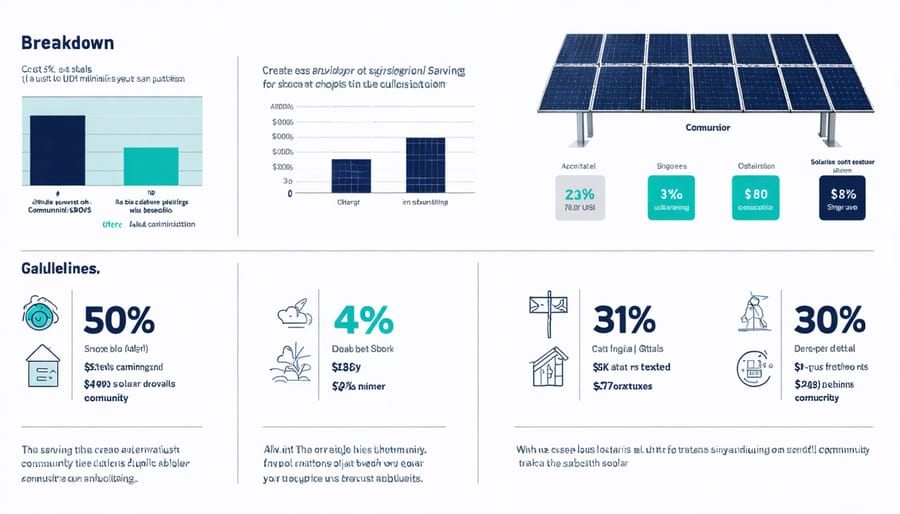
Environmental Impact
Community solar projects play a crucial role in reducing our collective carbon footprint while supporting Alberta’s transition to cleaner energy. When farmers participate in these climate-smart community initiatives, they contribute to significant environmental benefits that extend well beyond their own properties.
A typical 1-megawatt community solar installation can offset approximately 1,000 tonnes of CO2 emissions annually – equivalent to removing 215 cars from our roads. For Alberta farmers, this means contributing to cleaner air while maintaining productive agricultural operations. These projects help reduce reliance on fossil fuels, particularly during peak farming seasons when energy demand is highest.
The environmental advantages aren’t limited to carbon reduction. Community solar installations often utilize previously unused or marginal land, making efficient use of available space without compromising valuable cropland. They also support local biodiversity by creating wildlife corridors and providing shelter for beneficial insects and pollinators when properly designed with native vegetation.
Moreover, solar panels have minimal water requirements compared to traditional power generation methods, helping preserve our precious water resources. This aspect is particularly relevant for Alberta’s agricultural community, where water conservation is increasingly important. By participating in community solar, farmers become active stewards of environmental sustainability while maintaining their agricultural productivity.
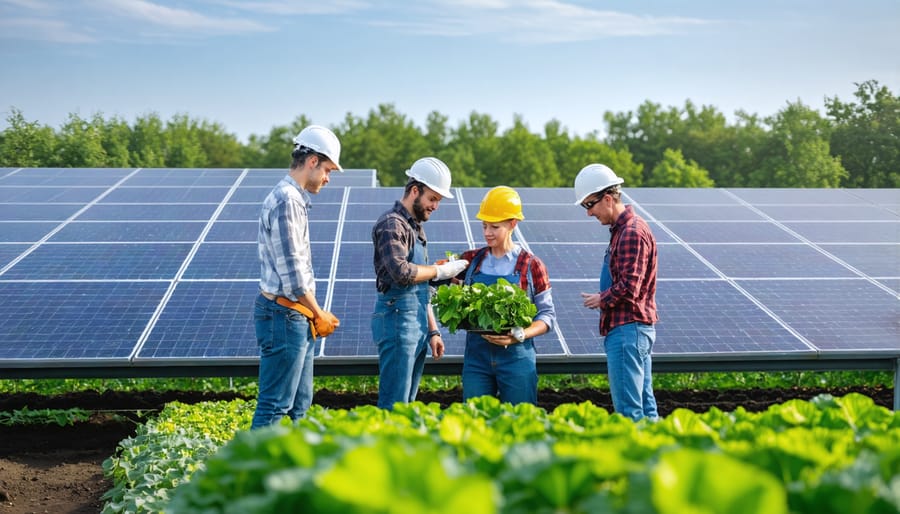
Case Study: Success in Southern Alberta
In 2019, a group of fifteen farming families in Vulcan County, Alberta, joined forces to create the Southern Alberta Solar Cooperative (SASC), demonstrating the remarkable potential of community solar initiatives in agricultural settings. The project now generates 2.5 megawatts of clean energy, enough to power 350 homes and multiple farming operations.
Sarah Johnston, a third-generation wheat farmer and SASC member, reports that her family’s annual electricity costs have decreased by 65% since joining the cooperative. “We were spending nearly $8,000 yearly on power for irrigation and grain drying. Now we’re looking at around $2,800, and that’s with increased production,” she explains.
The project required an initial investment of $4.2 million, with each farming family contributing between $75,000 and $150,000, depending on their energy needs. Through Alberta’s Rural Economic Development Initiative (REDI) grant program, the cooperative secured $1.5 million in funding, significantly reducing individual costs.
What makes this case particularly impressive is the innovative land-use approach. The solar installation occupies just 4 hectares of previously underutilized land affected by soil salinity, transforming a challenging agricultural area into a productive energy-generating asset. The project created eight full-time maintenance and operations jobs, contributing to local employment.
The cooperative structure allows members to share maintenance costs and technical expertise while providing flexibility in energy allocation. During peak irrigation seasons, farmers can utilize more of the generated power, while excess energy is sold back to the grid during off-peak periods, creating an additional revenue stream.
After three years of operation, the project has exceeded initial projections, with members expecting to reach their return on investment two years ahead of schedule. The success has inspired three neighbouring counties to explore similar initiatives, highlighting the growing recognition of community solar’s value in agricultural settings.
Practical Considerations Before Joining
Site Assessment
Before committing to a community solar project, it’s crucial to evaluate your property’s solar potential and infrastructure requirements. Start by assessing your land’s sun exposure, considering factors like shade from buildings, trees, or geographical features. In Alberta, south-facing areas with minimal obstruction typically offer optimal conditions for solar installations.
Your local utility provider can help determine grid connection possibilities and any necessary upgrades. Most Alberta farms already have suitable electrical infrastructure, but some may need modifications to accommodate solar integration. As part of smart technology adoption, many farms are finding that their existing power systems can be easily adapted for community solar participation.
Key assessment factors include:
– Available space (typically 2-4 hectares per megawatt)
– Distance to existing power lines
– Soil conditions and drainage
– Access roads for construction and maintenance
– Local zoning regulations and permits
Professional solar assessors can provide detailed site evaluations using advanced mapping tools and energy production modeling. They’ll analyze your property’s specific characteristics and recommend optimal placement for maximum energy generation. Many Alberta solar developers offer free initial assessments, helping you understand your site’s potential before making any commitments.
Remember to consider future farm expansion plans when selecting potential solar sites to ensure long-term compatibility with your agricultural operations.
Financial Planning
When evaluating community solar projects, understanding the financial commitment is crucial for making an informed decision. Most projects in Alberta require a 15-20 year agreement, but the long-term savings typically outweigh the initial investment. Farmers can expect to see a return on investment within 7-10 years, depending on energy consumption patterns and local utility rates.
The subscription costs vary by project size and provider, but most Alberta farmers report monthly savings of 10-15% on their energy bills compared to traditional utility costs. These savings can increase over time as conventional electricity rates rise. Additionally, many community solar initiatives qualify for financial support programs through provincial and federal initiatives, reducing the initial investment.
Consider that while there may be a modest subscription fee, you’re essentially locking in your energy rates for the next two decades. This provides valuable protection against market volatility and rising energy costs. Many projects also offer flexible payment options and the ability to transfer your subscription if you sell your property.
For a typical 160-acre farm operation, participating in a community solar project could result in annual savings between $2,000 and $3,500, with potential for greater returns as electricity costs increase. Remember to review the contract terms carefully and consider consulting with local agricultural financial advisors who understand the unique energy needs of Alberta farms.
Community solar presents a compelling opportunity for Alberta farmers seeking to diversify their income while contributing to sustainable agriculture. The evidence clearly shows that participating in community solar projects can deliver both immediate and long-term benefits, from reduced energy costs to stable revenue streams through power generation.
For many farmers, the combination of available grants, tax incentives, and shared costs through community participation makes solar projects more accessible than ever before. With average payback periods of 8-12 years and systems lasting 25-30 years, the financial case for community solar is strong, especially considering rising energy costs and increasing demand for renewable energy.
Taking the next step is straightforward. Start by connecting with local solar cooperatives or agricultural associations to learn about active projects in your area. Consider attending information sessions or speaking with neighbouring farms already participating in community solar initiatives. Many successful projects across Alberta demonstrate that community solar can work for operations of various sizes and types.
Remember to thoroughly review available funding options, including federal and provincial programs specifically designed for agricultural solar projects. Working with experienced solar developers and agricultural financial advisors can help ensure your participation aligns with your farm’s goals and capabilities.
By joining a community solar project today, you’re not just investing in your farm’s future – you’re becoming part of Alberta’s growing renewable energy community while maintaining control over your agricultural operations and energy costs.

